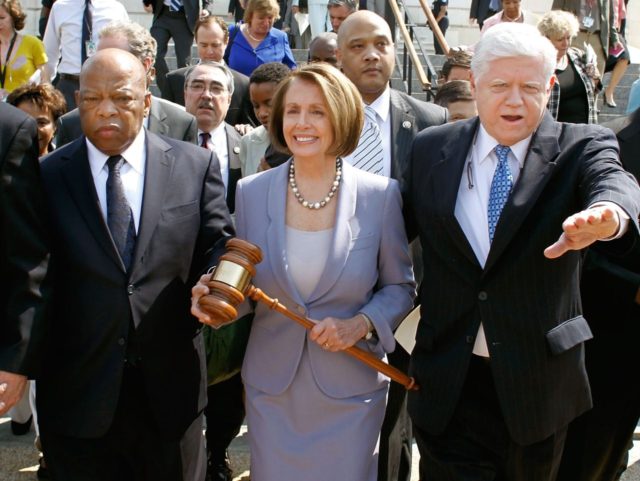Axios.com’s Mike Allen reports that House Minority Leader Nancy Pelosi (D-CA) is now considered a lock for Speaker of the House in 2019, as her party is expected to sweep the 2018 midterm elections.
If so, it would be one of the most remarkable comebacks in political history, after Pelosi led her party to an historic defeat in 2010 after serving as the first female Speaker for four years, then clung to power over a shrinking minority party for eight.
Allen notes: “It would take a flip of 24 seats for Dems to take over. The average loss for the president’s party in his first midterm is about 32 seats, and we’re hearing forecasts of 40+ losses.” He acknowledges, too, that the existing district map, and the past demographic patterns of voter turnout in midterm elections, favor the Republicans. But there are many signs of Democratic momentum, and many prominent Republicans have already retired their seats.
Pelosi came to power after the 2006 midterm elections, a wave that was propelled by public fatigue with the Iraq War, skepticism of President George W. Bush’s proposed Social Security reforms, and a series of scandals that hit House Republicans — including alleged sexual misconduct with congressional pages. Rep. Rahm Emanuel (D-IL) masterminded a campaign that recruited conservative Democrats to challenge Republicans in moderate districts.
The new Speaker had promised to “drain the swamp” in Washington. But that promise soon proved empty, as she backed Rep. Jack Murtha (D-PA), known for his abuse of earmarks, for Majority Leader. “Pelosi’s endorsement suggests to me she was interested in the culture of corruption only as a campaign issue and has no real interest in true reform,” said the left-wing Citizens for Responsibility and Ethics in Washington (CREW) at the time.
Ultimately, Rep. Steny Hoyer, from Pelosi’s former home state of Maryland, won that post. But Pelosi moved to exert her control over her party and over the House, centralizing control in the Speaker’s office to an unprecedented degree.
She cast aside the “regular order” of appropriations and authorizations and used her clout to muscle through massive pieces of left-wing legislation, including the ill-fated 2009 “stimulus” and, most notoriously, Obamacare.
Pelosi’s infamous statement that “we have to pass the bill so that you can find out what is in it” could easily have served as the epitaph of her political career and the Affordable Care Act itself. However, both are still around. Pelosi shut down internal challenges to her leadership, and presided comfortably over a caucus reduced to its liberal core. Meanwhile, Republican Speakers John Boehner (R-OH) and Paul Ryan (R-WI) were stymied by the Senate in their efforts to pass legislation they had promised to Republicans — including, but not limited to, Obamacare repeal.
Should Ryan yield the Speaker’s gavel, it would mark the end of a swift rise for the conservative policy wonk, now nearing 47 years old, who became chair of the House Budget Committee in 2011, was nominated for Vice President in 2012, and returned to lead the House Ways and Means Committee in 2015 before being elected Speaker.
Unlike 2006, Democrats are not running conservative candidates. They are running on a left-wing agenda fueled by opposition to President Donald Trump in districts where college-educated voters are leaving the GOP. They are buoyed by the “#metoo” campaign, which has been turned against Trump, though most alleged offenders are liberal Democrats.
Last year, Pelosi faced her first serious internal revolt. This year, she intends to have the last laugh.
Joel B. Pollak is Senior Editor-at-Large at Breitbart News. He was named to Forward’s 50 “most influential” Jews in 2017. He is the co-author of How Trump Won: The Inside Story of a Revolution, is available from Regnery. Follow him on Twitter at @joelpollak.

COMMENTS
Please let us know if you're having issues with commenting.